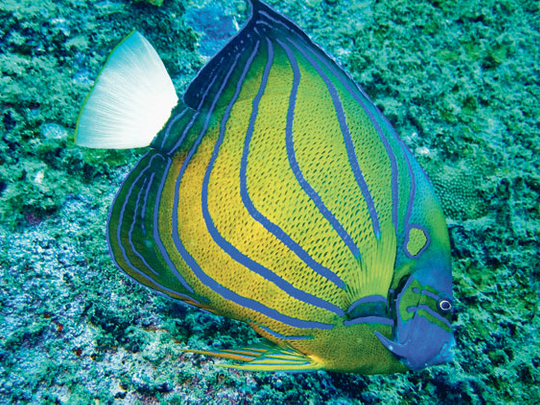
Mention Malaysia to scuba-divers and their first thought will probably be of Sipadan, off the east coast of Borneo. The marine reserve has crystal-clear waters and an ecosystem so rich, it wows even the most seasoned divers, drawing them back again and again.
But if you fancy some place not so easy to reach and worth every penny, the outlying islands of Terrenganu — a region in northeastern Peninsular Malaysia — will not disappoint. Independent travellers and groups are well-catered for and no permits are needed to dive around the islands.
The fun begins
Getting there can be half the fun, with Air Malaysia flights from Kuala Lumpur to Kuala Terrenganu. A short bus ride from Terrenganu airport to the boat harbour and you're just a 45-minute boat ride from paradise.
Typical vessels are small fibreglass speedboats. However, there is also an air-conditioned ferry besides long wooden fishing boats — which are much slower — to take you across.
The colour of the ocean will transfix you — the waters turn from blue to green to turquoise as the boat reaches its destination, which seems straight out of a picture postcard: coconut-fringed white beaches, greenery around the hotels and beach bungalows, and a tray of welcome drinks.
Offshore islands such as Pulau Redang, Pulau Lang Tengah, Pulau Kapas and Pulau Perhentian attract beachgoers and snorkellers with their pristine beaches.
Traders' stop
Perhentian Islands are two islands named Pulau Perhentian Kecil (small Perhentian island) and Pulau Perhentian Besar (large Perhentian island). The Malay name Perhentian is translated as "place to stop" and this is exactly what these two islands were for traders travelling between Malaysia and Bangkok in years gone by.
The islands offer a tranquil atmosphere. The quality of accommodation will vary depending on which side of the island you stay on. For example on Perhentian Besar, the Arwana Perhentian Eco Resort and Beach Chalet at Teluk Dalam Beach is not an eco-resort if only in its name. A sewage pipe also leads from the various chalets straight to the sea.
Luxury seekers should probably avoid this one but the at least 15-year-old resort has everything backpackers would need. The Arwana Dive Centre is a Padi Resort Dive Centre.
One guidebook's advice includes choosing your dive centre as some do not have the proper equipment to repair regulators as they are so new. On the other hand, the benefit of new dive centres opening is the low cost.
Ally Landes, events coordinator, Emirates Diving Association, has dived in Sipadan and Terrenganu. "Terrenganu was unknown territory and offered an exceptional underwater world of wonders. Although there is a 90 per cent coral bleaching manifest, the diving in this region is superb and the coral bleaching did not affect the discoveries made on each dive site," she said.
"There is such care taken in the underwater world over in Malaysia that some of the dive sites have been closed to divers to protect the corals from too much stress. The dive sites that are open are just as lively and picturesque as the next, each offering a unique topography and marine life, leaving you saddened every time you have to resurface but overly excited as you try to share what you had seen and, at the same time, you forget to take that all-important breath. Exquisite!"
Popular dive sites include the Pinnacle, also known as Tokong Laut or Temple of the Sea, a pinnacle jutting out from the seabed, and Sugar Wreck, an easily accessible 3,500-tonne sugar hauler.
Besides coral and fish, the Perhentians are home to turtles and many species of shark. During a week's trip and fitting in around eight dives, EDA divers recorded seeing hawksbill turtles, Jenkins whipray, blue-spotted stingray and bamboo shark, besides blue-ringed angelfish, yellowtail barracuda, bumphead parrotfish, giant frogfish and crocodile fish.
Tread softly to see the shy ones
Apart from footpaths that cut through the jungle, there are no roads on the islands. The only way to get around is by walking or taking a sea taxi. If you tread carefully, you may even encounter some of the islands' shy wildlife on the way, such as monitor lizards, fruit bats, squirrels or even mouse deer.
Redang, the largest of the isles dotting the South China Sea off the Terrenganu coast, offers great diving as the visibility is better. It is also the most expensive of the east coast islands. Redang is well known as a turtle sanctuary, and they usually lay eggs on Turtle Beach on the north of the island.
The proximity of perfect beaches makes all the islands worth visiting, either for a pure island holiday or as an add-on to a city trip to Kuala Lumpur.
Hope shines through
Earlier this year, several dive sites in Malaysia were closed to visitors due to coral bleaching. WWF-Malaysia's statement on coral bleaching said the closure of affected dive sites is a temporary measure to minimise further stress to the bleached corals.
However, it is important to take pre-emptive measures against events like this by putting more resources into marine protected area management, preventing coastal and marine pollution and promoting sustainable fisheries. WWF-Malaysia hopes that the Malaysian government will adopt and implement Ecosystem Based Management of Fisheries and strengthen Marine Protected Area Management and Integration.
A tourism-development case study of Perhentian in 2000 conducted by Coral Cay Conservation, a British group, concluded that any further development must proceed with extreme caution due to the size of the islands.
Megatourism projects were deemed to be inappropriate and the temptation to attract affluent tourists with international-type resorts must be avoided. It added that budget travellers dominate the traffic to Perhentian and planners should not fall for the misconception that they do not spend enough money.
The early results from Coral Cay's surveys show that divers have endured a gradual decrease in visibility during their survey work and the reasons for this are not known yet. Project scientists have recorded that many of the coral species spread their tentacles during the day, while many others usually feed at night. This may be a natural phenomenon or related to human impacts such as sedimentation. Suspended sediment reduces sunlight and clogs coral polyps. This makes it difficult for animals to feed. On the positive side, the marine team is delighted about the presence of the rare humphead wrasse, a threatened species, which is caught for live-fish trade.












